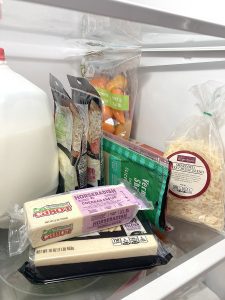 Can cheese be frozen?
Can cheese be frozen?
Some cheese can be stored in the freezer but it’s not recommended because it can change the texture. Harder cheeses like Parmesan freeze better than other types. Therefore, it is best to freeze harder cheeses that you intend to use for cooking rather than eating alone. It is best to freeze cheese in its original, unopened package. If it is already opened, cut it into small pieces and wrap tightly in plastic wrap and freezer paper. Thaw the wrapped cheese in refrigerator and use soon afterward.
Can I eat cheese if I’m lactose intolerant?
Yes, but it depends on the cheese. Harder cheeses like Parmesan and cheddar can contain little to no lactose since most of the whey (which contains lactose) is drained during production. Cheeses that are aged (e.g., 6 months or more) are safer since residual lactose is consumed by the cultures. It is best to avoid some softer cheeses like Ricotta and Mozzarella that are higher in moisture and are not aged.
Can I eat the rind of cheese?
It is always a good idea to ask your cheese seller first but many rinds are edible. Some cheeses are coated in wax or sealed with other materials and those should be removed or cut around. Other than that, it is really a matter of personal preference since the flavor of some rinds can be strong and at times can overwhelm the flavor of the cheese itself.
What is the liquid on the outside of my cheese and what should I do?
This is not uncommon and is usually just whey (like you find in yogurt) that you can just wipe off.
What should I do if my cheese gets moldy?
Cheese can develop mold after it is exposed to air. Thankfully, most molds are harmless and can be cut away from larger pieces. To do so, cut away about a half inch on all sides of the visible mold growth avoiding contact with the mold so you don’t spread it. If it still tastes a bit musty or moldy, continue to cut away. The same does not apply to soft cheese like cream cheese, ricotta, etc. since the mold can spread more easily in these products and will be difficult to avoid. Similarly, it is best to discard sliced or shredded cheese that has developed mold.
How should I store and handle cheese?
It is best to store all cheeses in their original unopened package in the refrigerator at <40°F. Be sure to wash your hands and any utensils before handling and try to avoid touching cheese you plan to put back in the refrigerator. It is best to keep cheeses in their original package, especially sliced or shredded cheese. Don’t put your hand directly into the bag either- pour shreds out or use a clean utensil to remove slices or shreds. Tightly wrap or seal the cheese (or the original packaging) before putting it back in the refrigerator. You can also place the wrapped cheese in an airtight container if you have one. You can take cheese out of the refrigerator to come to room temperature before you plan on eating it but don’t leave it out for too long as the texture will change and fats may seep out as oil on the outside. Place any leftover cheese back in the refrigerator as soon as you’re done.
How long can I store cheese and can I eat it after the listed date on the package?
Code dates are not tied to the safety of the product but rather the quality. The length of storage depends on the type of cheese and the storage and handling conditions. Harder, aged cheeses like cheddar and parmesan will store well in the refrigerator for a few months but will eventually develop mold once opened. Softer cheeses have higher moisture content and may spoil faster. They should be eaten by the date listed on the package. Be sure to check all cheese for mold, slimy textures, and off-odors before eating. Shredded and sliced cheese should be used quickly after opening since molds can develop relatively fast.
What is the white stuff on the outside of my cheese and what should I do?
Assuming the cheese is unopened it is not likely to be mold but rather calcium lactate crystals. These are common and not harmful. Over time calcium and lactate can naturally migrate to the surface of cheese and crystalize to the point that they are visible to the naked eye.
Why are there crunchy things in some cheeses?
Some aged cheeses naturally develop “cheese crystals”. Most of the time they are either calcium lactate or crystals of the amino acid tyrosine. They are safe to eat and often desirable since they are usually a sign that the cheese has been aged for some time and has developed flavor.